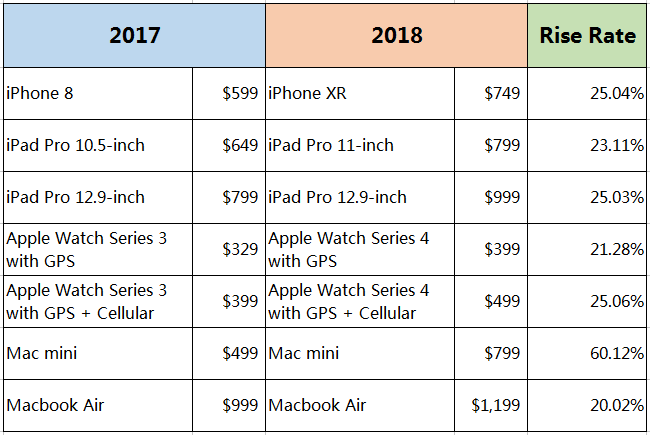 1619
1619
 2018-11-09
2018-11-09

Apple has officially rolled out its full suite of products for 2018 and beyond. It’s an impressive slate of Macs, iPhones, and iPads, and they will no doubt top many a wish list during the holiday season.
Now that we know exactly what Apple will be selling for the next 12 months, a disturbing trend has emerged, one that gives new meaning to the word “more.”
First, let’s take a look at last year’s entry-level pricing for new products:
iPhone 8: $699
iPad Pro 10.5-inch: $649
iPad Pro 12.9-inch: $799
Apple Watch Series 3 with GPS: $329
Apple Watch Series 3 with GPS + Cellular: $399
Mac mini: $499
MacBook Air: $999
Those are all expensive for sure, but not necessarily luxury. And now take a look at this year’s prices:
iPhone XR: $749
iPad Pro 11-inch: $799
iPad Pro 12.9-inch: $999
Apple Watch Series 4 with GPS: $399
Apple Watch Series 4 with GPS + Cellular: $499
Mac mini: $799
MacBook Air: $1,199
Here's the comparison:

It is obvious that if you take away older discounted products, Apple has increased the cost of entry to buy an Apple products across the board by no small amount over last year. All said, you’re looking at an average price hike of $150. That’s a significant year-over-year increase, and that’s not to speak of the $5,000 starting price for the iMac Pro.
It only goes up from the "bottom." This year, the customizable options for the iPhone, iPad Pro, Mac mini, and iMac are all much higher than they were last year. You can configure the Mac mini with options that put it at an insane $4,199. Do the same with the 12.9-inch iPad Pro and it nearly eclipses $2,000 before you add a Pencil and Keyboard, which also cost more than last year. What gives?
There seems to be three reasons why Apple would hike prices so astronomically:
The price of components has increased by a significant amount.
They’re so innovative that research and development costs are astronomical.
Growth will start to slow dramatically and Apple wants to compensate with higher prices.
Click Macworld to know more details.